8. Vice in Every Village, Poverty in Every Cottage
Crabbe 1807 - 1812 The Borough and Tales 1812
By Kate Pugh
Poems 1807 went into three editions. Crabbe immediately set to work to finish The Borough, the collection of verse-tales for which he is now best known. This was published in 1810, to a more mixed reaction. Crabbe’s work seemed disturbingly radical to some readers, who complained of ‘disgusting representations‘ and a deliberate dwelling on squalor, ‘The fact is, that Mr Crabbe … sees nothing but vice in every village, and poverty in every cottage.’ (1). Certainly Peter Grimes has not lost its power to shock. Crabbe’s biographer, Neil Powell, suggests that the creation of Grimes, ‘one of the great tragic characters in English Literature‘ owes its imaginative force to Crabbe’s own experience. The portrait of Grimes, ‘untouched by pity, unstung by remorse … broken by want, disease, solitude and disappointment‘ was close to Crabbe’s father. The knowledge of the progress of madness came from Crabbe’s experience with his wife, while the nightmares were his own. (2)
In spite of some disapproving reviews, The Borough went into six editions and Crabbe followed it with Tales 1812, another collection of verse-narratives centred round a series of contrasting characters. His main motive was to raise the money to pay for his sons’ university education.
Amongst the letters of congratulation Crabbe received on the success of his work was one from Walter Scott, which marked the beginning of their friendship.(49) Scott confessed to having admired Crabbe’s work ever since he read The Village and The Library in his youth. Another admirer was Jane Austen, who named the heroine of Mansfield Park after Crabbe’s character in the Marriages section of The Parish Register, and made sure to have Fanny Price include Crabbe’s Tales amongst her favourite books. (3)
Crabbe’s most famous and most powerful poem, Peter Grimes, is firmly rooted in Suffolk, but the characters and events in many of his other verse narratives could belong equally well in Leicestershire. J.H.Evans suggests quite convincingly that certain sections of his later work refer to St Mary the Virgin, Bottesford, which Crabbe would certainly have known well and where he preached:
‘Now sad and slow with cautious step I tread,
And view around the venerable dead;
For where in all her walks shall study seize
Such monuments of human state as these?’
The ‘witchcraft tomb’ is refered to specifically;
‘Behold these infants in the frame beneath!
A witch offended wrought their early death;
She formed an image, made as wax to melt,
And each the wasting of the figure felt;
The hag confessed it when she came to die,
And no one living can the truth deny.’
Crabbe had obviously read The Wonderful Discoveries of the Witchcrafte of Margaret and Philippa Flower and learnt that Joan Flower
‘….was a servant fitted for her place
Experienced, cunning, fraudful, selfish, base;
Skilled in those mean, humiliating arts,
That make their way to proud and selfish arts’
whose familiar was ‘a grey old cat’.
References
(1) Monthly Mirror, August 1810, quoted in Powell p.201
(2) Powell, pp 192-198
(3) Letters, Letter from WalterScott, 21st Oct. 1812
(4) Noakes














Comments about this page
There was certainly vice in Muston in the early eighteenth century! While researching the 1719 Will of one of my ancestors, Robert Padget, I found that the document had been witnessed by the then rector, Edmund Vernon. His activities were described in “The Ecclesiastical Courts of the Archdeaconry of Leicester in the eighteenth century and early nineteenth century” by W.A. Pemberton:
A minister who believed that he should have all this life’s pleasures, especially those of the flesh, was Edmund Vernon rector of Redmile. William Wake had noted that
‘Mr. Vernon, Rector of Redmile, has also Muston with it, without a curate. He is by promise to leave this country for a while to satisfy his Grace the Duke of Rutland, and is
to have a curate to supply his place as I shall approve of.” Not even the devices of his powerful patron, who was anxious to preserve the honour of the Church, could shield
Vernon from that which no ecclesiastical court, however, weak, and no churchwarden, however indifferent, could ignore, namely his shamelessly immoral liason with Elizabeth George, the servant of Peter Leadbetter, who kept a public house in Melton Mowbray. However vile was his conduct, at least Vernon sinned openly. This woman, ‘deemed widely as a lewd wanton and unchaste person’, had the rector of Redmile ‘often hugged and embraced in an indecent manner’. The prosecution alleged that it was popularly known that they had often committed fornication together, not only in Leicestershire but in many
places in Rutland and Lincolnshire. Witnesses deposed that Vernon was depraved beyond all redemption being ‘given to drinking, fuddling, lewdness and wanton talk and to hunting after loose idle and lascivious women of ill credit and reputation’. On one occasion he had
got into bed with a man in mistake for the said Elizabeth and was chased into the road attired only in his shirt. He had tried to bribe the man not to tell. Vernon had behaved to such a shamelessly immoral extent that once after drinking until the late hours of the night in a booth at the fair at Waltham on the Wolds, he had, in a field, and in full public view, committed adultery with his mistress. The bestial cleric was sentenced by the bishop to be deprived.
Add a comment about this page